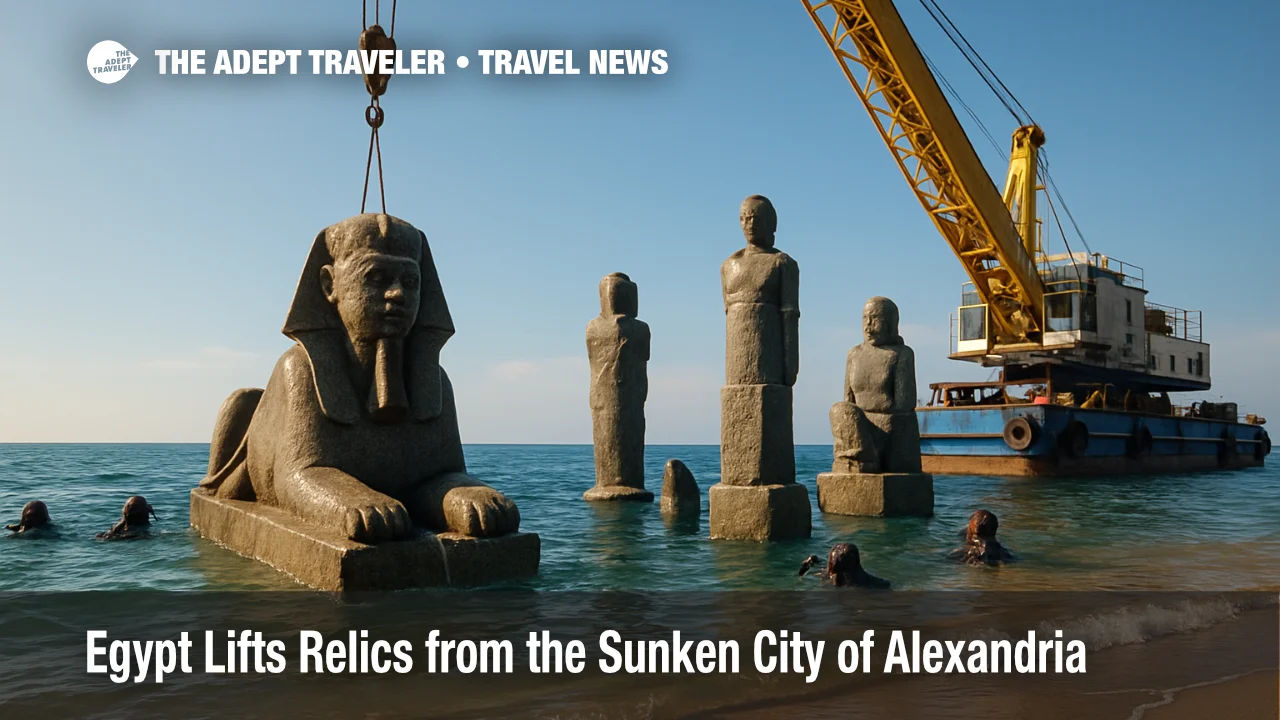Egypt lifts relics from sunken city Alexandria

Egypt on August 21, 2025 unveiled newly recovered antiquities from waters off Alexandria, confirming that structures and statues at Abu Qir Bay likely extend the ancient city of Canopus. Crews used cranes to raise pieces selected under strict heritage criteria as divers who helped locate them watched from shore. Finds include limestone buildings, reservoirs, rock-carved ponds for fish cultivation, and statues ranging from Ptolemaic to Roman periods, among them a sphinx bearing the cartouche of Ramses II. Officials also highlighted a 125-meter dock, anchors, a merchant ship, and a harbor crane tied to long maritime use.
Key Points
- Why it matters: Underwater discoveries reinforce Alexandria's status as a global hub for Greco-Roman history and underwater archaeology.
- Travel impact: A six-month "Secrets of the Sunken City" exhibit in Alexandria adds a timely cultural draw for Mediterranean itineraries.
- What's next: Egypt is studying an underwater museum in Abu Qir Bay to showcase Canopus and nearby Heracleion.
- Strict retrieval standards mean most submerged heritage will remain in situ for research and protection.
- Climate risks to Alexandria heighten urgency around conservation planning and visitor access.
Snapshot
Authorities say the Abu Qir Bay site, just northeast of central Alexandria, may be an extension of Canopus, a major religious and commercial center in Ptolemaic Egypt that later thrived under Rome. The Ministry of Tourism and Antiquities opened a six-month exhibition, "Secrets of the Sunken City," at the Alexandria National Museum featuring 86 artifacts recovered from Abu Qir Bay and the city's eastern harbor. Travelers typically route via Borg El Arab International Airport (HBE). For planning background on seasons, routes, and cultural highlights, see Egypt.
Background
Canopus and the nearby port of Heracleion flourished along the Canopic branch of the Nile as gateways for trade, taxation, and worship. Over centuries, earthquakes, subsidence, and rising seas drowned districts of both cities, leaving temples, statues, and harbor works under shallow Mediterranean waters. International teams, working with Egypt's Supreme Council of Antiquities, have mapped quays, shipwrecks, and sanctuaries, then curated select objects ashore to minimize disturbance to submerged contexts. The new exhibit concentrates on daily life and ritual, including marble and granite statuary, royal iconography, domestic water systems, and aquaculture basins that hint at coastal economies straddling Ptolemaic, Roman, and later Byzantine use.
Latest Developments
Artifacts raised off Abu Qir Bay underscore the site's scope
On August 21, cranes hoisted a limited set of objects chosen under conservation rules, while divers who assisted in the work cheered from the beach. Highlights include a partially preserved sphinx inscribed with the cartouche of Ramses II, beheaded and fragmentary Ptolemaic figures in granite, a lower-half Roman nobleman carved in marble, and coins. Archaeologists also documented a 125-meter dock, stone anchors, a merchant ship, and evidence of a harbor crane, indicating small-craft activity that persisted into the Byzantine period. Officials emphasized that most structural remains will stay underwater to preserve context, focus research, and mitigate exposure risks.
New exhibit and a potential underwater museum in Alexandria
The "Secrets of the Sunken City" exhibition, inaugurated by Tourism and Antiquities Minister Sherif Fathy and the Alexandria governor, runs six months at the Alexandria National Museum. It presents 86 pieces from Abu Qir Bay's Canopus and Heracleion zones and from the submerged Royal Quarter beneath Alexandria's eastern harbor. Separately, the government is studying an underwater museum concept for Abu Qir Bay, with feasibility work exploring limited diver access, purpose-built viewing, or expanded land displays, all aligned with UNESCO guidance. The aim is to protect in-situ heritage while developing a sustainable cultural attraction.
Analysis
For travelers, Alexandria's underwater archaeology offers a rare lens on Greco-Roman Egypt, with conserved finds now accessible in a single venue. A curated, time-bound exhibit concentrates demand, creating a near-term incentive to add Alexandria to Mediterranean circuits, Nile programs, or Red Sea itineraries without overexposing fragile offshore sites. An underwater museum, if it advances, would broaden access yet raises operational challenges, including visibility, currents, insurance, diver training, and strict artifact protection. The most realistic path blends limited, supervised in-water experiences with robust on-land interpretation, digital reconstructions, and rotating exhibits.
Conservation urgency is real. Studies cite land subsidence, coastal erosion, and sea-level rise as accelerating pressures on Alexandria's shoreline, with building failures and emergency coastal defenses already reshaping the corniche. Reporting also reiterates a stark forecast that, even under a best-case UN scenario, about a third of the city could be underwater or uninhabitable by 2050. That context makes the current retrievals and museum programming more than spectacle; they are risk-aware steps to document, interpret, and safeguard a world-class heritage zone while channeling tourism in ways that reduce strain on the sites themselves.
Final Thoughts
Alexandria has long balanced maritime commerce, scholarship, and spectacle. The new recoveries, the museum exhibit, and the underwater museum study show a pragmatic blend of access and restraint, favoring in-situ preservation while meeting traveler curiosity with curated storytelling. For visitors, Alexandria is again a stage where the sea reveals chapters of Egypt's layered past. For stewards, it is a test of climate-smart heritage management. As exhibits rotate and feasibility work proceeds, demand will grow to see, not disturb, the sunken city Alexandria.
Sources
- Remnants of 2,000-year-old sunken city lifted out of the sea off Alexandria, The Guardian
- Photos show 2,000-year-old artifacts pulled from sunken city off Egypt's coast, CBS News
- Minister inaugurates "Secrets of the Sunken City" exhibit, Ministry of Tourism and Antiquities
- Egypt opens submerged antiquities exhibition in port city Alexandria, Xinhua
- 'Secrets of the Sunken City' exhibit reveals Alexandria underwater heritage, Ahram Online
- Egypt considers underwater museum to showcase sunken cities off Alexandria coast, Ahram Online
- Newly recovered underwater antiquities showcased in Alex, Egyptian Gazette
- Rising seas and shifting sands attack ancient Alexandria from below, Reuters
- Sinking Alexandria faces up to coming catastrophe, AFP via Phys.org
